|
FAQs about Caryophyllid Coral Disease, Pests, Predation
11
Related Articles:
Coral Pests and
Disease; pests, predators, diseases and conditions by Sara
Mavinkurve, Caryophyllid
Corals, Elegance Coral,
FAQs on Euphylliid Disease:
Caryophyllid Disease 1,
Caryophyllid Disease 2,
Caryophyllid Disease 3,
Caryophyllid Disease 4,
Caryophyllid Disease 5,
Caryophyllid Disease 6,
Caryophyllid Disease 7,
Euphylliid Health 8,
Euphylliid Health 9, Euphylliid Health 10,
Euphylliid
Health 11, Euphylliid Health 12,
Euphylliid Health 13,
Euphylliid Health 14,
& Elegance Coral Disease/Pests,
FAQs on
Euphylliid Disease by Category:
Diagnosing, Environmental
(Pollution/Poisoning, Lighting...),
Nutritional, Social (Allelopathy),
Trauma,
Pathogenic (Infectious, Parasitic, Viral)
Predatory/Pest, Treatments
FAQs on Stony Coral Disease by Category: Diagnosing,
Environmental (Pollution/Poisoning,
Lighting...), Nutritional,
Social (Allelopathy),
Trauma,
Pathogenic (Infectious, Parasitic, Viral)
Predatory/Pest,
Treatments
Caryophylliids 1,
Caryophylliids 2, Caryophylliids 3, Caryophylliids 4, Caryophyllid ID, Caryophyllid Compatibility,
Caryophyllid Systems,
Caryophyllid Selection,
Caryophyllid Behavior,
Caryophyllid Feeding,
Caryophyllid Propagation/Reproduction,
Stony/True Coral,
Coral System Set-Up,
Coral System Lighting,
Stony Coral Identification,
Stony Coral Selection,
Coral Placement,
Foods/Feeding/Nutrition,
Disease/Health,
Propagation,
Growing Reef Corals,
Stony Coral Behavior,
|

|
|
Wall Hammer Coral skeleton showing
9/25/15
Thanks for taking the time to help me out.
<Welcome>
I have a wall Hammer with some tissue missing and I was hoping for some advice
on what to do to help the coral.
<Mmm; usually starvation (chemical imbalance or lack of useful food), or trauma
involved here>
I just recently purchased a wall hammer coral that my wife had fell in love with
at the NLFS, Non-Local Fish Store, an hour away from my home. When is it local?
How far away is it non local?
<Got me; good question>
The wall hammer coral is in a "y" shape. I noticed it had some tissue recession
on the 3 ends of the coral and I asked the store owner about the recession and
he said its not a problem.
<Usually not>
I had my reservations, but I bought it anyway. Now that it is in my tank some of
the flesh has come off on the 3 areas and is showing bare skeleton, only 1 area
has some loose flesh hanging on it and I do not see any brown jelly. I did do a
drip
acclimation and I did a Bayer dip before adding the coral to my display.
Incidentally, I had some Stomatella snails fall off in the Bayer dip, which I
had been wanting to get for my tank, but at a minimum I always want to do some
protection before putting anything in my display.
<Good; isolation would have been better for a few weeks>
Other than the problem areas, the coral looks great is moving in some flow and
it seems to recede or puff up as the flow changes in my tank. I have had it in
my display for 48 hours.
My temp is 77.5, sg is 1.024, ph is 7.95-8.15,
<A little low>
Alk is 8.5, calcium is 440,
Mag is 1300.
<I do hope/trust that you have some; a modicum of NO3, HPO4 present>
Should I do anything to help the coral?
<Yes; read; likely dose iodide-ate>
Do you think it will be OK?
<Already stated>
Will the flesh grow back on the skeleton or lay down more skeleton over the dead
area?
<Yes; if....>
Thanks for your help.
Thanks,
<Read here:
http://www.wetwebmedia.com/CaryDisDiagF.htm
and the linked files above, where you'll lead yourself. Bob Fenner>
|
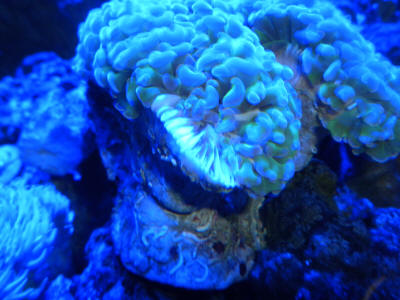 |
|
Frogspawn issues
I noticed on Euphylliid health on your website about pests and parasites and
different solutions. I have not noticed any hitchhikers. The thing I
noticed that my nitrates are high
<How high is high?>
and that I changed over to a max gyre wave maker and ever since that I noticed
the frogspawn respond differently in that it has not all bloom as nice as
before. The wave is not so high to put a lot of current on the frogspawn section
that is being effected. These are a few more different pics that might
be able to help with my issue.
<See some dead heads... long since>
Also I noticed last night a small piece of frogspawn tips on the sand bed.
<Happens; a type of "bail out".... specimen-saving behavior.... escape mechanism
from poor conditions locally. You need to find out what these "poor cond.s"
are... Too little of something/s, too much of...?>
Could it be a fish picking at it.
<Doubtful; Euphylliids/Caryophylliids aren't very palatable... too stinging when
healthy>
I have a coral beauty, yellow tang, blue throat trigger bi color blenny and a
Melanurus wrasse. Can I send you a video of my tank and maybe that would be more
helpful?
<You can send a link to the video you post on the Net; but again;
something/s wrong w/ the environment here (the list of possibilities is very
long).... When, where in doubt, large changes.... water changes, replacing
substrate, a good deal of new live rock.... best perhaps moving the colony to
some place new that's established (another system)....>
As I said before this frogspawn is about 20 yrs old. It is or was pretty hearty.
Thanks again for your response. I much appreciate it
<I'd be reviewing the environmental diseases of Scleractinians, the
Families therein; posted on WWM.
Bob Fenner>
Frogspawn issue
Oh yeah I forgot. I also use revive coral cleaner
<Don't know much about this>
when I introduce any new corals which everything else is doing real good other
than a section of the frogspawn. Also how would I administer iodide-ate
and hexose sugars?
<See/Read on WWM re... the search tool....>
Do I take the coral out or dose the tank?
<The latter likely>
Thanks,
Vasilios
<Welcome. BobF>
Re: Frogspawn issues
Thanks for the quick response
<Ah, welcome>
|
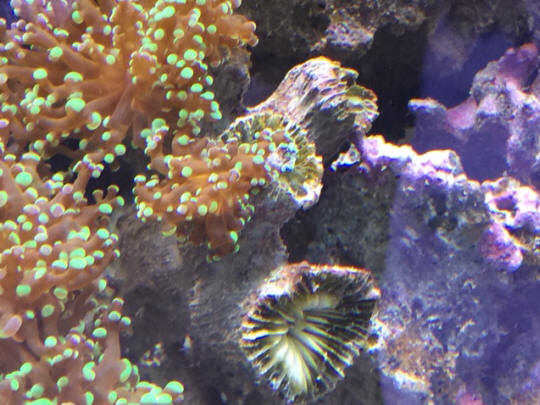 |
|
Re: Frogspawn issues
Hello Mr. fennel. I forgot to mention that I have a purple lobster also a blue
and orange Linckia and yellow mesh starfish. Would they be an issue with the
frogspawn?
<Mmm; not likely. They might be crawling over the colony, but shouldn't result
in the dead areas shown in your pix>
I have had them for a couple of years without problems
Thanks,
Vasilios
Re: Frogspawn issues
Nitrates is 75
<MUCH too high. For reef systems you want to keep [NO3] under 10 ppm maximum.
SEE/READ on WWM re nitrate control.
http://wetwebmedia.com/nitratesmar.htm
and the linked files above. Bob Fenner>
|
|
Frogspawn; hlth. diag. 7/14/15
I am trying to figure out why some of the frogspawn is not blooming. I
have not changed anything in my tank. The frogspawn is around 20 yrs old. What
can I do to remedy this? Help
<Mmm; well; same ole checklist of possible predators, deficiency syndromes
(alkalinity, P, K)... usual shake n' bake possibility of trying to flush out
pest/s.... administration of iodide-ate and hexose sugar/s... Have you read on
WWM re Euphylliid health?
Bob Fenner>
|
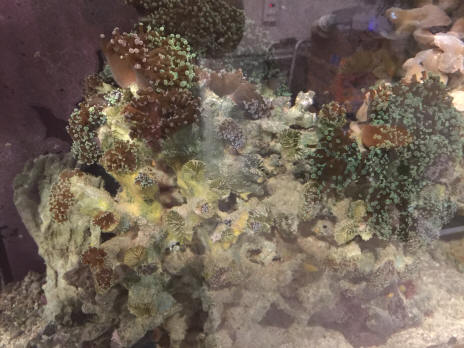 |
|
Hammer Coral Questions 4/25/15
Hello Bob,
<Hey Vinh>
It's Vinh again hoping to pick your brain. I have these two corals that I'm
concerned about. They're both hammers. One is the common green branching hammer,
which seems to have turned snow white on the stalk, but the
head seems fine. Is this from a lack of light? I do feed weekly.
<Might be from just being close to the other... I'd give them another few inches
space>
I read through your FAQs section and did find a similar case, but wasn't sure if
this case was referring to the tentacles or the stalk:
""Bleached hammer coral Hi I have a 29 gallon mini reef that has a branched
hammer coral that turned white a few months ago.
<likely from a attrition (starvation from lack of light and/or lack of target
feeding) or salinity/temperature shock. The latter can occur and not effect all
coral... different tolerances with each. Do you recall a sudden increase in heat
or a lapse in evap top off followed by the dumping of a sudden large amount of
freshwater in to compensate? If not... the coral was simply starving... very
common. Many poorly lit or underfed coral can go 6-12 months before finally
waning noticeably> It doesn't open as large as before but otherwise it seems
fine. It has been like this at least 6 months. <Yikes>
The other one is an orange wall hammer, the left side is turning translucent. Is
that a sign of bleaching, possibly from a lack of light as well?
<Possibly; but could be due to many other causes... a nutritional deficiency,
prior stress...>""
I have a Maxspect Razor 16K LED 27". It's 16" above the surface of the water.
The quarantine tank is 12" deep. Do you think I need to increase my lighting
intensity?
<Worth trying; or moving the specimen/colony up closer to the light. Do you have
access to a PAR, PUR meter? Maybe the LFS can lend you one>
Below is my lighting schedule:
Time Intensity
8:00 0%W
1%B
12:00 6%W
9%B
14:00 12%W
35%B
15:00 29%W
42%B
21:30 0%W
1%B
Here are my latest parameters:
Salinity: 1.023
<I'd raise this to 1.025-6>
PH: 8.23
Temperature: 77 degrees
Calcium: 450
Magnesium: 1500 (on the high side so I've since started lowering the
dosage
Alk: 9.1
Phosphate: .1
Nitrate: 0 (I've cut back on the carbon)
<Need some measurable NO3; this could be "it">
<Bob Fenner>
|
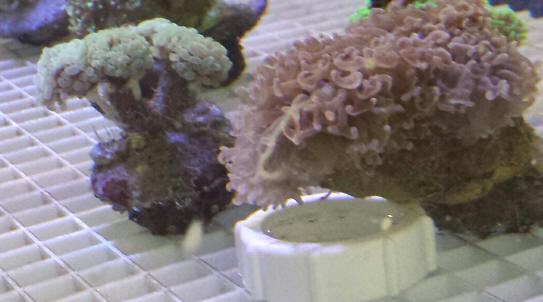 |
|
Trying First Coral Addition - Green Hammer. Starved, and?
12/27/14
Hello All
<Tom, Annette>
Sorry in advance for the length but want to give you as much detail as
possible!
<Good>
I have been stymied in my attempt to add the first coral to my 55g
FOWLR. I have tried consulting with local experts but have not been able
to get any answers. It is a small branching hammer I currently have on
the bottom in the sand partially sheltered by my rock. It still has
color but keeps mostly retracted. I have had it for about 3
weeks and it has never opened fully like it was at the sellers.
<Mmm; could be "many" things different here. Several water quality
possibilities, lighting, circulation, allelopathy, pests...>
Here are my system details: 55g 4 foot tank, 2 Chinese make 120w led
(taotronic or similar actinic and white) currently set at min levels -
blue on 12 hours whites 10) set at 9" above water,
<... see WWM re PAR/PUR and the needs of Caryophylliids...
likely there's insufficient (too low intensity) light here>
40b sump in basement with SC Aquariums 302 skimmer additional rock and
Chaeto, filter socks at DT drain (with bag of CupriSorb) and
reactor outlet,
<Uhh; do you have measurable NO3 and HPO4? Necessary>
300w heater, BRS reactor w/ carbon, 32g brute can (2nd sump in line used
for additional volume and mixing sw), JBJ top off fed from 2nd brute can
that holds RODI (well water run through whole house neutralizer using
calcium carbonate and 4 stage RODI with TDS of 0 - also used for water
changes which is 10g a week with IO), pan world 100px return pump, total
volume approximately 105g.
I have been set up for 2.5 years. I have a pair of B&W ocellaris (2
years now), algae blenny
<Could be hassling>
(1 year), six line wrasse (<year) and flame angel (<year).
<This too>
I had a very hard time adding the angel, taking 6 tries to get one that
survived. I attribute that more to the frailties of the fish than
anything else. My current flame is very healthy and the King of the
tank! It and the six line are buds! I feed 1-2 times a day alternating
between LRS, Hikari mysis, Hikari brine/algae, New Era pellet and some
Nori once in a while.
Current parameters are (they stay pretty consistent):
Temp 79.3
Sal 1.023 (refractometer)
<Needs to be NSW strength (1.025-6>
Ammonia <.02 (salifert and SeaChem alert badge)
Nitrite 0 (API)
Nitrate 0 (API)
<Absolutely necessary. SEE WWM RE>
Copper 0
Phosphate 0
<... this too. Chemo-photosynthates can't live w/o>
(I do currently have some Cyano which I am trying to siphon out)
KH/Alk 9.6 / 3.42
Calcium 350
I feel like I am doing everything right but can't figure out this
hammer. I am on my second attempt and they both have reacted the same
way. Looks ok at first but then retracts into the skeleton. I have not
seen any picking
by my fish. I do not direct feed the coral. I have been cleaning my
filter socks by soaking them in a water/bleach solution but I also run
them through the washer with AmQuel. So perhaps low levels of chlorine?
I also thought some heavy metal from the well water but it gets pretty
well filtered I think. Here is a photo, not the best but gives you an
idea of how retracted it is. This is pretty much how it has been.
Help! I am at a loss.
Tom Myers
<What's that saying? At least some of your/its problems are obvious.
Keep reading. Bob Fenner> |
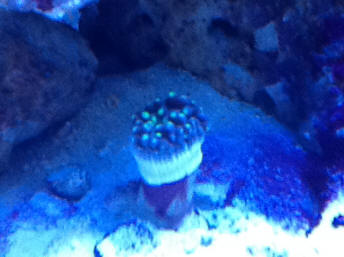 |
|
Re: Trying First Coral Addition - Green Hammer
12/28/14
Bob,
<Tom>
Thanks for the quick reply. Oh and happy holidays! I can work on increasing
the lighting. I guess I thought it was not opening due to too much lighting.
<Not just this, but yes; move this "specimen up" on the higher rock>
I will also get the salinity up. I just recalibrated the refractometer and
it was running high so I will adjust with my next water changes.
That and I will work on dirtying up my water I guess! I will stop the
CupriSorb and carbon and see if that helps.
<Good>
I really don't think it's any of the fish. I have never seen any of them pay
any attention to the hammer. The flame swims by all the time. Never even
takes a look. But I will keep an eye out.
Thanks again for input.
Tom Myers
<Measurable nitrate and phosphate... BobF> |
HAMMER DEATHS... no data;
rdg. 5/15/14
Hello Mr. Fenner and Crew,
<Dai>
I have an ongoing problem that I cannot solve and all the people at the
LFS can’t solve either. I hope you can help me. I have several healthy
colonies of hammers and frogspawns
<Have you searched on WWM re Euphylliid health?>
that used to thrive for several months but now are dying (losing 1-2
heads per day). I do not have any fish that eat corals and other corals
in the tank are GSP, Pipe organs, mushrooms, Montipora, Palys and they
are thriving.
<The Shrooms and Zoanthids are strongly allelopathogenic>
I have good lighting, good water flow (no direct currents) and reef
parameter water chemistry. I have been keeping reef for over 10 years
and I can’t pinpoint on the cause. I have a 210 gallon reef tank. I have
moved the affected colonies to the hospital tank after giving them 10
minute immersion disinfectant two days ago but they keep going down
hill. Any advise is appreciated. Dai
<... no data proffered that lead to any sense of etiology for me. Let's
have you do that alluded to reading. Start here:
http://wetwebmedia.com/CaryDisDiagF.htm
and the linked files above. Bob Fenner>
white bugs on Euphyllia
1/2/14
Hi Bob,
I have been trying to search information on your site about white “bugs”
that seem to specifically infest Euphyllia species, but haven’t found
anything.
<Any chance of a decent pic?>
A Google search has found a few threads from various aquarists and
there’s disagreement on whether they are harmful or not.
<Well; the planet does "show", "exhibit" may be better, all range,
degrees of commensalism, predation et al. relations twixt species,
individuals>
Some say that they disappeared on their own, others say they killed
their corals.
<I can believe/imagine all>
They are not the “typical” copepods that tanks typically have visible on
the glass, and are too small for me to capture on my camera (I tried),
<Maybe a friend has a cheapy scope... there are some really spiffy ones
you can order for cheap that will allow imaging to be recorded>
but this link shows a decent picture of them
http://www.ultimatereef.net/forums/showthread.php?t=473550 .
<Uhh, look like little white zots... could be most anything...>
I have two paradivisas, one ancora and one glabrescens. I mostly see
these bugs on the Torch, though I wouldn’t say it’s being swarmed or
anything. They are not very active, some crawl slowly, some seem to be
partly imbedded into the coral...perhaps feeding on the coral?!
<... what would Doug Adams say/write? "Don't panic">
I have seen the odd one on the divisas, never the ancora. All corals seem
well with the exception of the Torch, which has been slowly receding
over several months. Not sure if the recession is related, as I have had
some recession issues with some other LPS species which do not show any
kind of “bugs”...so I’m not sure if there’s a cause and effect here, or
purely coincidence. Are you familiar with these critters, and can you
tell me whether they are a problem and should be treated somehow, or
harmless?
Thanks,
Dave
<... Are you in China? If the US, UK, I'd go w/ not guilty till proven
so... BobF>
Re: white bugs on Euphyllia 1/3/14
Hi Bob! I'm in Toronto, Canada, so I will assume not guilty until proven
otherwise. Interestingly some hobbyists wrote that they treated with dog
heart worm medication to kill them, and their Euphyllias rebounded and
started looking better.
<This might (well) not be a cause-effect event. Beware of anecdotal
accounts>
They're simply too small to get a good photo with my current camera, and
I don't have access to a scope...there are other photos on line and even
a video on YouTube that someone made to show them, but in all cases they
just look like white dots. I had noticed them for months before
realizing they crawled and were thus alive. For now I will just continue
to monitor. Thanks again. Dave
<Such small critters tend to come and go in captive systems. I would not
over-react. Cheers, BobF>
Elegance coral and worms in skeleton
8/13/13
Hi,
<Kel>
It's been ages since I've had to ask you guys for some help, usually
reading through is all I need to do as you guys have so much knowledge
on so many topics already. It's fantastic and super helpful in this
hobby.
<Ahh!>
About 6 weeks ago a bought a small elegance, it was bagged and a
acclimated it to the tank through drip, placed it on the sand in my
tank, 30 inches below a 40 watt LED DIY light.
<Should be fine... at this "great" depth and lowish light... See my art.
re Catalaphyllia captive husbandry on WWM. There are "stands" of this
species from shallower (tens of feet) depths, but most in the last
several years have been collected from several tens of feet... low
light>
It's been happy, getting fed Mysis, brine, and it's also been taking
spectrum pellets which happen to fall into it every second day or so.
Tonight it closed up and I noticed three circular dents in the skeleton,
which indented into the fleshy part of the coral. I noticed one of this
dents when I placed it in the tank, but I thought they were empty and
harmless misshapes in the rock. However tonight it appears to be that
the little holes/dents actually contain flat headed cream coloured worms
approx 6mm in diameter.
<Mmm, more likely these are (mesenterial) parts of the Elegance itself;
showing themselves... >
They emerge from these hollow dents and are sensitive to light, when a
torch is shined on them, they retract into the tubes which are embedded
in the skeleton. The elegance seems to have grown around them, despite
the animal being an entire cone itself, not fragmented off a reef.
<Yes; this is how this species "grows", lives... as a sort of "V" stuck
in muck, bottom sand plus>
I'm not sure if they pose a problem, and am curious is some kind of dip
may be best to get rid of them? What are you thoughts?
<Leave all as is, and do read the materials on WWM if you haven't
already>
Thanks very much,
Kelly
<As many welcomes. Bob Fenner>
Re: Elegance coral and worms in skeleton
8/19/13
Thanks for such a prompt reply, ill take a photo of the 'worms' next
time I see them. It's more a tube worm facing up out of the skeleton
rather than the small worm like filaments that are actually
mesenterial... But I could easily be wrong haha. What I'm seeing are
similar to worms which emerge out of large circular tubes on live rock
sometimes
<A possibility; and quite common is some Poritids, Pocilloporids... Have
rarely seen/encountered in Catalaphyllia... are perhaps "too stinging",
fleshy...>
You don't think the lighting level may be too low?
<I'd use a PAR or PUR meter, measure at the place/site of the
specimen... a score of 100 is fine here. BobF>
Bubble Coral; Faux/CNN news hlth...
8/3/13
I have tried to research this topic from various places, including your
website, and you have been able to help me in the past, so I thought I
would contact you. About two months ago, a bubble coral that I had was
thriving. Then, out of nowhere, it looked as though it was not doing
well at all.
<In what ways?>
The alkalinity was a little low,
<... numbers please>
but otherwise I could not find any other chemistry that was a problem.
<? Is this a guessing game? What did you test for?>
In the last three weeks, the coral has sort of rebounded, but not on it's
normal skeleton. Two pieces fell off,
<?! Very bad>
and for awhile, they looked just like dying coral, but now are looking
like they are turning into their own pieces of healthy coral. I'm not
sure if this happened due to the chemistry, or if it's part of a natural
life cycle. One looks as though it's created its own mouth. I'm most
concerned about their lack of anchoring though. They are very light and
float around and turn upside down very easily because there is no
skeleton yet holding them down. Should I just leave them alone, or is
there a way to attach them to a rock?
<A few ways... gone over on WWM. You're familiar w/ our search tools?>
It does seem that if they turn upside down, they end up right side up
before the day is done. Your insight is appreciated as always.
Thank you,
Mike S.
<... Mike, you left out the NEWS and went straight to the
commentary... Too like the mass media nowayears... Let's have
you read here:
http://www.wetwebmedia.com/EuphHlthF10.htm
and the linked files above for a while, rather than wait, go back and
forth trying to get and yield useful information.
Bob Fenner>
|
Zoox expulsion and recession 6/11/13
Hello!
I have a 1 year old 120 gallon reef tank. Only 3 fish, a couple of
gobies and a Royal Gramma. Lights are 2*175 Watt MHs with 2*54 Watt T5s.
Temperature is typically 78 degrees, Nitrates under 5 ppm, phosphates
haven’t measured. There is a little nuisance algae but not much.
Alkalinity and calcium have been a little low, with 6 kH, and 360 ppm
respectively.
<What re Mg?>
Last week I started adding alkalinity to get it up, and added Kalk to my
ATO. I do a 5-10% water change with RO water/salt every 1-2 weeks. There
are 2 Koralia 1400 pumps plus the return, and circulation seems more
than adequate. Corals are all LPS, 4 Euphyllia, 1 Trachy, 1 lobo, 1
Caulastrea, a couple Favia/Favites. I have a couple of new Monti Caps in
quarantine.
About 6 months ago when I added 2 Euphyllia glabrescens, one Indo and
one Aussie, I noticed them ejecting what I’m positive was
Zooxanthellae. It was dark brown, thick and stringy. Though I feed my
corals weekly with Mysis, there was too much for it to be waste and it
was too dark. I shrugged this event off as unimportant, because the
corals seemed otherwise fine.
<Mmm, and the reason for this expulsion? Heat, change in lighting,
addition of Cnidarians...?>
About a month ago I was away on vacation, and when I came back, one of
the other Euphyllias, an Ancora was quite bleached. I’m guessing it may
have been a heat spike since the weather got warmer, and my building had
yet to switch over to air-conditioning from heating (it’s an older
building). Since then I noticed that the Ancora would shrivel up
whenever the metal halides would turn on. I moved it down, and reduced
my metal halide photoperiod from 7 hours down to 5 (the 2 T5s are on for
12 hours).
<Good>
It still would react negatively to the metal halides, even thought the
175W 14K Hamilton's I have are suppose to be a pretty low PAR bulb.
<I'd be measuring PAR/PUR at their depth>
I kept reducing halides duration until I found with a 2 hour photoperiod
(T5 still at 12 hours) the Hammer began to look better, more full. It
continues to look good, though still bleached, as long as I keep the
halide photoperiod short.
This brings me to the last couple of days. I noticed that one of the
torches shows some recession. Not to where the septa are exposed yet,
but tissue has risen pretty close to where the septa might start, and
some white skeleton at the “neck” of the polyp is exposed. The polyps
are inflating normally otherwise. Tonight I noticed the torches again
ejecting large amounts of Zooxanthellae towards the end of the
day, as the polyps were starting to close up. Their color hasn’t
changed. The part I find surprising is that I thought this usually
happens with excess light, but I only have a 2 hour metal halide
photoperiod now!?
<Along w/ whatever else is going on here, this is evidently too much>
Clearly something is up with 3 of my Euphyllias. One bleached, one
receding and ejecting something, and a 3rd only ejecting something. The
4th, what I think is a E. yaeyamaensis, looks perfect, inflating nice
and huge, and with zero recession and zero expulsion of anything but
normal waste. The other corals also look good.
Is this perhaps not light related?
<Something else "is going on", but what? Perhaps another unseen invasive
organism... could be a (micro) nutrient shortage...>
Is my photoperiod too short now? Can alkalinity of 6 be the source of the
problem? Can you offer any wisdom or ideas as I’m not sure how to
proceed?
<Yes... I'd try the product Zeospur 2 here, as a supplement... Do read a
bit re others impressions... on the Net>
Thanks so much,
Dave
<Welcome. Bob Fenner>
|
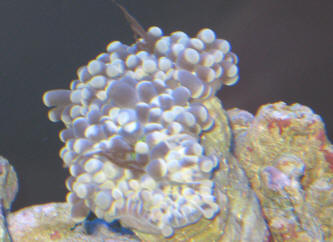 |
Fw: Zoox expulsion and recession
6/11/13
Hello WWM crew! I sent this email/question last night, but thought I should
have added another picture for clarity. One is of the Aussie Torch expelling
what I think is Zooxanthellae, and the other I just added, is of the
recession of the other Torch coral. Sorry for any confusion this may cause.
Dave
<Mmm, thanks for the additional pic... am concerned re the red spot at the
base of the colony... is this BGA? If so, either it, or the conditions
allowing for it may be the root of the issue here. Please search, read on
WWM re Cyanobacteria. Bob Fenner> |
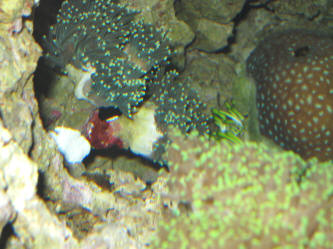
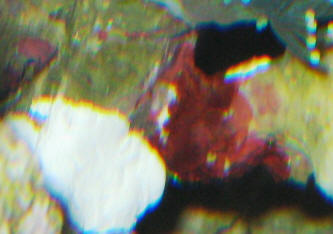 crop
crop |
|
Re: Zoox expulsion and recession
6/12/13
Hi Bob,
Thanks for getting back to me. You asked if it was BGA on the skeleton.
I stuck my hand in and gave it a scrape. It feels velvety, but did not
come off.
<... likely IS BGA then... can you look at a sample under a 'scope?>
It doesn't seem to be coralline, and doesn't seem to be Cyano. I think
that spot has been there since I got the coral about 5-6 months ago. I
actually did have some persistent Cyano on the substrate a couple months
back, but after some suctioning with water changes it seems to be mostly
gone other than a small spot near my Trachyphyllia that comes and goes.
I want to keep my halides at 2 hours a day for the next while, with the
two 54W T5s at 12 hours, since my bleached hammer seems to prefer this.
Is this a problem for my other corals, for the next month or two?
<Not likely; no... most aquarists over and mis-light their
photosynthates... think on this; the sun is only directly overhead a bit
every non-cloudy day... Not much, often. And photosynthetic organisms
are very capable of adaptation>
Also, could the
slightly low alkalinity and calcium be the cause of my problems?
<More likely an imbalance issue; most often w/ Magnesium... when in
doubt, test, do water changes>
I will check out the product you named. Thanks again!
Thank you,
Dave
<Welcome. Bob Fenner>
|
Is my torch coral bleaching?/Coral Health 3/26/13
Dear WWM crew,
<Hello Jae>
Hello. This is Jae, and I had a question regarding my two torch corals
in my tank. I have recently bought two torch corals and have drip
acclimated them into my tank. The green torch coral(at left in image)
seems to be fine, but my yellow-brown torch's(on the right) color seems
to be a little strange. Most of the tentacles are pink-white from stem
and brown near the top. Is this suppose to be its own natural color? Or
is my torch coral on the right starting to bleach? The water parameters
are fine in my tank: ph is 8.2, ammonia and nitrite are 0, nitrate is
near 0 ppm, salinity level is 1.024, and calcium level is 440. I have
jasmine polyp and colony polyp as well and they are doing absolutely
fine. Also, is my torch coral on the right fully extended? Both torch
corals are placed on bottom of the tank (metal halide lighting) under
medium current.
<The Zooxanthellae living within the coral's tissue are responsible for
the coral's color. Generally a change in light intensity and/or
spectrum will cause a color change in the coral, hence the term
"bleaching". Sometimes the Zooxanthellae will not adapt to this
change in lighting and will die.
It doesn't appear that your coral is bleaching, at least not yet.
Try reducing the photoperiod by a couple of hours and let this be your
photoperiod for a couple of weeks. Then you can slowly increase
the photoperiod by 30 minutes every two or three days. Corals
coming from lower intensity lighting or a different spectrum should
always be light acclimated. Please read here.
http://www.wetwebmedia.com/CoralColorMaintGasta.htm>
Thank you!
<You're welcome. James (Salty Dog)>
 |
|
Re Is my torch coral bleaching?/Coral Health 3/26/13
Thank you very much for the advice.
<You're welcome.>
I currently leave my metal halide on for 7 hours each day. Will cutting down
the time to 4~5 hours for about a week affect my other corals?
<Mmm, seven hour photoperiod...I'd cut back to five hours the first week and
then bump it up an hour each additional week.>
Thank you!
<You're welcome. James (Salty Dog)>
|
|
|

